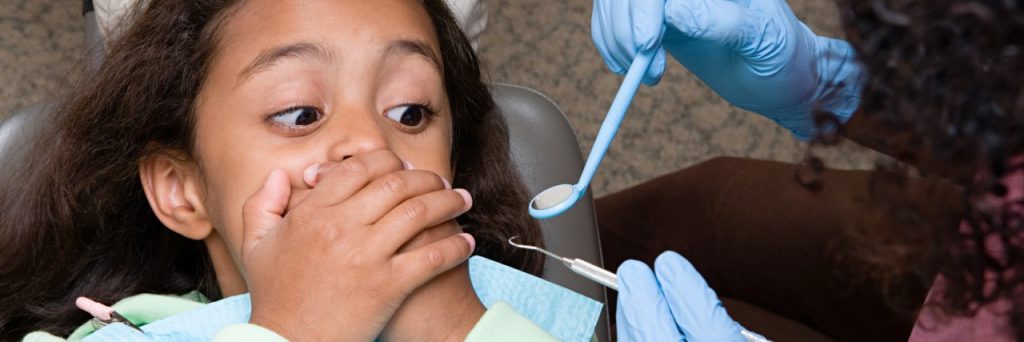Going to the dentist can cause anxiety for many of us, but it can be a challenging experience for those on the autism spectrum. Due to sensory issues, patients with autism can have difficulty staying still and allowing the dentist to do what’s needed in their mouth.
The most common dental problems seen in patients on the autism spectrum:
Proper oral health can be a challenge for some kids. While some dental problems seen in autistic patients can be purely genetic, sometimes they are a result of poor oral health due to sensory issues.
Kids with autism may seem “uncooperative” or display behaviors at the dentist and at home, so the proper amount of care can be difficult to achieve. Periodontal disease and cavities are the two most common dental problems we see in autistic patients.
Other common dental problems patients with autism may be more prone to include:
- Gingival overgrowth.
- Early and late tooth decay.
- Severe, early periodontal gum disease.
- The habit of constantly grinding teeth, which is also known as “bruxism.”
- Tooth anomalies that are related to the size, shape, and the number of teeth present in the mouth.
- Accelerated, inconsistent, and/or delayed eruption of one or more tooth.
- Pits, discoloration, lines, and other developmental issues seen in teeth.
Depending on each individual on the autism spectrum, some patients have difficulty communicating their pain. This results in dental health issues becoming so advanced that general anesthesia is not just required to help them relax, but also necessary for the pain or the needed procedure.
Dr. Greg Grillo DMD says, “Patients with ‘severe’ autism or other conditions that cause the patient to have difficulty with cooperation during dental treatment are many times better served by seeing a pediatric dentist. Pediatric dentists have received additional training beyond dental school and have the experience to help patients with [disabilities] receive necessary dental treatment while minimizing fear. They also have the ability to use sedation and even perform treatment in a hospital setting if needed.”
Patients with autism, especially children, tend to have significant sensory and oral motor integration issues. This can make the dentist a frightful experience. All of the tools, noise and people can easily overwhelm a patient and result in a meltdown. A lot of dentists will suggest a sedative right away.
Patients with autism may have a general fear of the dentist because it overrides their senses and is a lot to process in a short time. Finding a dentist who knows and understands their fears and who has experience working with other patients with disabilities is the best way to help your loved one slowly overcome their fear.
Special needs dentists.
Dentists who only care for patients will disabilities are typically hard to find, but they are out there. These dentists require an additional three years of dental postgraduate training. If you find one, they may be the best option for your loved one. Special needs dentistry is a definite option, so ask your local dentistry office if they have any information that could help you in finding one.
If your child is under your dental insurance, call them and inquire about any specialized dentists covered in your dental insurance policy. You may find out that a special needs dentist is covered under your policy — but don’t have your hopes set too high.
Ask for recommendations.
Speaking with a friend or other family member who parent kids on the autism spectrum is a great way to find recommendations for dentists. Once you have a recommendation, do some additional research to see whether or not you believe the recommended dentist will be a good fir for your child.
Your doctor may also have some suggestions on how to find a qualified dentist to work with your child. They may know someone because some dentists work closely with doctors who treat patients who require extra supports or interventions.
Adaptive equipment.
If your loved one uses a wheelchair, make sure the dentist you choose is ADA compliant and has the necessary equipment to work with your child. Even though this should be standard in all practices, it is not always a reality at all dental offices. Make sure to ask before you book your appointment. The last thing you want is to bring your loved one to their appointment and be unable to access a building or find out they are not set up to allow room for mobility devices or have adequate equipment if your child is unable to transfer to their chairs.
Possible split visits.
If your loved one simply cannot relax during a cleaning or any other procedure, and several issues need to be addressed, consider splitting the visit. A special needs dentist specifically is more likely to offer this solution.
How to help your loved one at the dentist.
Social stories are a great ay to help children understand and visualize what happens at the dentist.
Visit the dentist with your child on a day when they will not have any oral work done. This allows them to familiarize themselves with the environment, see the lights and hear the sounds. This may also be a great way to identify potential triggers and find possible solutions or create a plan for the actual appointment. You can also tell your child about your experiences at the dentist, even if it’s not the same one, and explain why it is important to take care of our teeth.
Consider bringing a favorite toy or comfort object, it may ease tension and anxiety.
Sedation isn’t always scary.
Sometimes sedation is necessary to ensure patients get the proper care they need for their oral health. For patients with autism who become overstimulated and experience a meltdown, sedation may be the best way to get a proper look at their teeth and perform the necessary dental work. Some people have concerns about this because they do not want their loved one to be sedated, but it’s often the only way to get the work done.
Sedation dentistry is pretty common and used on patients with and without disabilities. Sedation dentistry, also known as “sleepy dentistry,” helps patients with anxiety. Keep in mind that this is not the same thing as having a patient under anesthesia. Sedation dentistry keeps the patient somewhat awake and does not cause them to go to sleep completely.
In this type of situation, you can ask your dentist about seeing a specialist who can give you all of the information you’ll need. Oral sedation dentistry may be the best option you’ve got if you know for a fact your child will refuse the treatment they need.
Letting the dentist know your loved one has a disability and may require accommodations is the first step. It helps your dentist and the staff plan ahead to make the visit as successful as possible.
Oral health at home.
Proper oral care is important for our overall health. Poor oral hygiene can lead to multiple issues, such as decaying teeth and loss of bone structure in the jaw. Therefore, taking the necessary steps at home to ensure healthy teeth can result in less invasive dentist visits.
Brush teeth regularly: Teeth should be brushed at least twice a day. If possible, angle the brush 45 degrees to the line of the gums while brushing the soft tissues and the base of the teeth. For the surface of the teeth brush in a circular motion up and down, and avoid horizontal strokes that are too harsh.
If your child struggles with brushing due to sensory issues, it may be tricky to properly brush twice a day. Brush your teeth along with your child, or do it by yourself at first, to show them that it’s important and an important habit. You may also want to try a spin toothbrush, or a toothbrush designed specifically for kids with oral aversions.
Give flossing a try: Flossing may be extremely difficult to do, but it’s worth giving it a try. Start by getting your loved one familiar with dental floss and then show them how it works. You may not be able to do it for them for quite some time, but incorporate it into the entire routine just so they know that it’s important for proper oral health.
Keep the routine regular: Stick to a routine. Even if your child has yet to fully participate in the oral care routine, it’s important that you stick to it. It’s a good idea to let your child observe your routine with brushing and flossing. As long as they see you keeping up with your oral health, especially after you are constantly telling them how important proper oral hygiene really is, you’d be surprised how much your child is able to process while they watch you.
It may take your child some time to get used to the sensation of having a toothbrush in their mouth, so remember to be patient and keep in mind that all your hard work to help them will pay off in the end. Staying calm and being patient is easier said than done, as teeth brushing can be a frustrating experience for parent and child, but it can become a tolerated part of their daily routine.
This article was originally posted by Jamie Brown on The Mighty
Related news:
Ongoing WAAA Event:
Friendship Matters!
http://www.washingtonautismadvocacy.org/updates/advocacy/friendship-matters/
For registration, please email Fanta Cora <fanta@washingtonautismadvocacy.org>.



